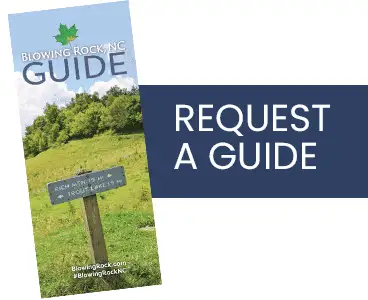One of Blowing Rock’s most beloved pastimes is hiking in the beautiful surrounding wilderness. When heading out to a short, familiar path, you can often just grab a water bottle and go. But sometimes you may be in the mood for exploring a new trail or taking a longer hike, and it’s always best to be prepared! What do you need for a new or longer hike?
We reached out to Brian Baldwin, an outdoors expert and the manager at Footsloggers in Blowing Rock to find out. We asked him what is absolutely necessary to pack for a day hike, and then followed up with what would be nice to have. Here’s his basic list:
- Start with a comfortable backpack
- Water and food
- Extra layers
- Basic first aid kit
“First and foremost, you should have a comfortable backpack that straps over both shoulders and wears level,” Brian explains, “nothing one-shouldered, or cross body.” Having a proper fitting, level backpack can decrease wear on your body and make the overall hiking experience more enjoyable.
Pack extra water and food. Always pack more than you think that you need. Water is one of the most important things you can take on a hike because you can still get dehydrated when it is cold outside. Even gentle hikes can get your blood flowing and work up a sweat. At the same time you’ll want to pack enough snacks that if you’re out longer than planned, you won’t go hungry. Brian focuses on high protein and high fat snacks like quality protein bars, nuts, dried fruits, dates, and jerky. These foods are also lightweight and easy to pack. Make sure you pack out all of your trash- don’t leave bottles and wrappers on the trail.
You’ll also want to pack a layer that can go over what you’re wearing. Brian recommends a shell so that if it rains you can stay dry, if it gets cold, you have an extra layer to keep you warm, and it can also work as a windbreaker. When packing, we like things that serve more than one purpose so that we don’t have to pack as much and a shell does just that.
Often, when people ask what to wear to the mountains or to go hiking they are told to wear light layers, or to layer up. What does “light layers” really mean? We had our expert weigh in and give us some advice. He said to make sure that the clothes are breathable, but not cotton. “Cotton does not wick away moisture, and can cause skin to get very cold very quickly when damp,” explains Brian. For moderate to warm weather, synthetic materials can work very well. However, in cooler temperatures Brian recommends Merino Wool. Merino Wool is hypoallergenic and works well to regulate temperature. Some layering examples include a long sleeve shirt, a light fleece jacket, a rain shell, light gloves, and a beanie (knit cap).
Gloves and a beanie often get forgotten, but they are great lightweight ways to stay warm and they fit in your pockets. We mostly lose heat around our head and neck so a beanie can go a long way when it comes to keeping us warm.
Be sure to pack a first aid kit for small emergencies, too. “Blisters are very common when hiking, and you’ll want to have bandages on hand for that,” Brian explained. Even if you have to turn around to go back to the car, walking on a blister can be extremely uncomfortable.
When asked what would be nice to have but is not in the mentioned above, Brian brought up water filtration and additional emergency gear.
- Water filter
- Headlamps
- Space Blanket or Bivouac Sack
- Whistle
Water filtration allows you to utilize natural water sources like springs and creeks without concern over getting sick. It also allows you to pack less water which is the most important, but heaviest thing that we pack. “Instead of packing two liters of water, you can just pack one and then use the water filtration to fill up your bottle,” Brian explained. If you get a filtering system it is extremely important to understand it and its limitations. There are numerous articles online about how to choose a water filter that is right for your purposes.
“You’ll want headlamps in case it gets dark before you get back to the car,” says Brian. This varies a little based on the time of day you are hiking, but is especially important during winter and spring when the sun sets early and more quickly. If there is even a chance you may not make it back to the car before dark, having a headlamp is a great comfort.
Brian recommended a space blanket or bivouac sack in the event that you have to sleep outside. A space blanket is a lightweight blanket that can be packed for extra warmth, and a bivouac sack is a small, packable shelter. And lastly, if you happen to get lost on a trail, a whistle can signal your location so that emergency services can find you and help you get back to safety. Remember: staying on the trail is important and can help prevent getting lost.
We hope that you feel more prepared now to take on a longer hike around Blowing Rock. Remember to bring enough water and snacks, wear light layers with a proper backpack, and if you are going somewhere remote or on a long hike, to pack your safety equipment. Also be sure to pack out your trash and Leave No Trace!






